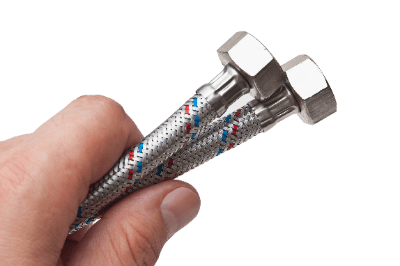What Is a Plumbing Hose?

A plumbing hose is a curved pipe used for plumbing.
It is usually used with nipples or joints at both ends, and many products made of metal, plastic, or rubber are sold. Gases, liquids, and fluids can flow through a plumbing hose.
Uses of Plumbing Hoses
- Connecting equipment and facilities and passing fluids between them
- Sending compressed air in pneumatic equipment
- Pumping sugar and other liquids into tanks
- Draining temperature-controlled equipment
- Gas piping
Plumbing hoses with variable shapes are used in places where plumbing pipes are not long enough to be used. Since they can be easily installed even if the piping is off center, construction work can be labor-saving.
Also, because of its variable shapes, it is more resistant to vibration than pipes. Connecting a machine that vibrates a lot with plumbing hoses will affect other machines, but plumbing hoses can suppress vibration. Hoses are also useful for connecting equipment that is used in motion.
Principle of Plumbing Hoses
Hoses are variable pipes and have long been used in many situations. Usually, plumbing hoses and plumbing pipes are used in different locations, but plumbing hoses are used when the length can be freely changed and the shape of the pipe can be varied to suit the location.
Types of Plumbing Hoses
Plumbing hoses can be made of metal, plastic, or rubber. There are many types made of resin, including those reinforced with wire or resin, those made of chemical-resistant materials, and those that are flame-retardant or static-free.
In terms of shape, some hoses are also sold in arbitrary locations, such as adjustable hoses, which allow the hose to be bent at right angles, and which do not have the shape of a typical hose.
Many plumbing hoses are regulated by law, and plumbing hoses for gas must be selected in accordance with the Technical Standard for Gas Facilities. In addition, water piping used for water supply is required to meet the standards outlined in the Water Supply Law Enforcement Order.
How to Select Plumbing Hoses
Plumbing hoses are selected according to their intended use. Note that the material, thickness, and other needs vary depending on the substance to be passed and the location of the installation.
1. Material
Chemical Resistance
Plumbing hose material is selected according to the object. Especially for corrosive substances such as acids and alkalis, chemical-resistant materials should be used, but chemical resistance differs for each material.
For example, metal hoses are weak against acidic substances. Nylon resin is stable against most inorganic chemicals such as liquid ammonia and sulfurous acid, but is weak against oxidizers such as hydrogen peroxide and chlorine decolorizers, and cannot be used for pipes that need to be disinfected with chlorine. Since each material has its strengths and weaknesses, it is important to select a material that is resistant to each substance.
Electrostatic Properties
When plastic resins, flour, and other materials are conveyed using piping, static electricity must be taken into consideration. Static electricity tends to build up and sparks can cause explosions. In such cases, materials that do not generate static electricity must be used.
Visibility
Transparent plumbing hoses are convenient for the visibility of flow rates, but light must be blocked out if light-sensitive materials are to be conveyed.
Heat resistance
High-pressure steam may be used to sterilize piping in the food and pharmaceutical industries. This is because if water stays in the pipes, a biofilm, a film of bacteria that is difficult to remove, may form. In such cases, piping made of heat-resistant materials should be used.
2. Pressure
Plumbing hoses that are expected to be under pressure should be thick or reinforced with wire or resin.
3. Thickness
The thickness of the plumbing hose is determined by the flow rate of the piping. If it is too thick, it will cause more loss, and if it is too thin, it will cause leakage.
4. Method of Use
Select plumbing hoses that are easy to use, such as an adjustable hose if you want to move the position of the hose, such as for supplying lubricating oil, or a bellows type if you need to expand or contract the hose depending on the liquid level. If the hose is to be used for food, use a plumbing hose made of a resin designated as a food additive.